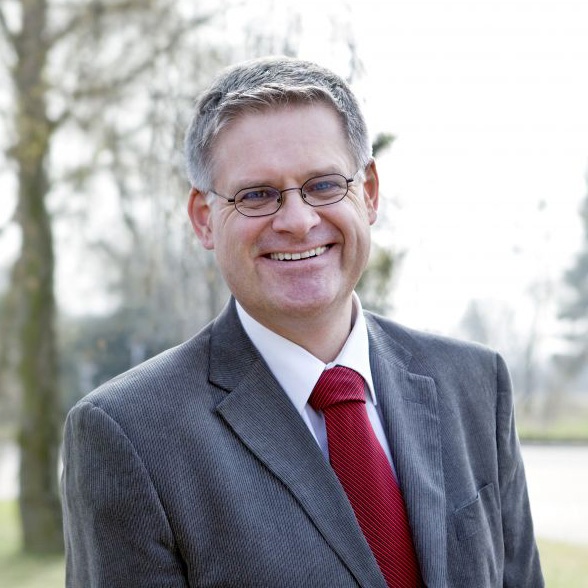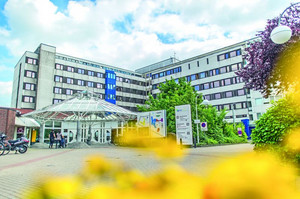Tuesday, 23. June 2020
Hospitals across Germany are currently bracing for a sharp rise in COVID-19 cases. This is making patients with respiratory disease very nervous, regardless of their age. We discussed the current situation with Hospital Director Prof. Dr Kamin.

Prof. Dr. Wolfgang Kamin: Patients should stick to the self-isolating guidance and should only leave their home if they really have to. They should always have the same caregiver and ideally that person should also do their shopping for them. If patients with respiratory disease do leave the house, they should wear a face mask. While it does not provide 100 per cent protection, it does reduce the risk of infection by at least 50 to 60 per cent. This applies especially if both parties are wearing a protective face covering, and we are going to be seeing more and more shop staff wearing a mask. If both parties wear a mask, it is now assumed that this can offer 80 per cent protection. Of course, a standard mask or even a homemade mask will never offer 100 per cent protection. Only FFP2 masks offer this level of protection, but these should ideally remain in hospitals as we will otherwise soon run out of adequate protection for hospital staff.
Prof. Dr. Wolfgang Kamin: Patients with chronic respiratory disease should continue their treatment as usual. This also applies if the treatment plan includes corticosteroids. They should not stop taking the drug containing corticosteroids. This applies to everyone and anyone, regardless of whether they have COPD, asthma, cystic fibrosis or PCD. If your doctor tells you you need to inhale a preparation containing corticosteroids, then please do so. For instance: Asthmatics run the risk of uncontrolled asthma attacks if they discontinue corticosteroids. If they contract COVID-19 on top of uncontrolled asthma, the situation will be much more critical than if they continue corticosteroid inhalation while taking careful precautions to avoid becoming infected.
Prof. Dr. Wolfgang Kamin: I ran a survey today of the 30 paediatric hospitals in this area where the average hospitalisation rate in the last two weeks has been a single patient per hospital. That is very, very low. Across the board, all children had a very mild illness. In most cases, the parents contracted the virus and passed it on to the children. The children varied in age and included one infant, but also a 17-year-old. There were also children who randomly tested positive, so in other words children who presented to the hospital with another problem and who were by chance discovered to have COVID-19. Most children stayed in hospital for two to three days and 80 per cent are already back home and have made a full recovery. Of these hospitalised children only one had a pre-existing condition, in this case heart disease. Even this child with heart disease had a mild progression and could be discharged after three or four days. In this case, doctors erred on the side of caution and kept the child under observation for longer to be on the safe side.

Prof. Dr. Wolfgang Kamin: Here in Hamm we had around 270 infected adults. Of these 270, 40 have been admitted to hospital to date. This means that about 15 per cent of patients with COVID-19 had to be admitted to hospital at some point. Of these 40 hospitalised patients, twelve have needed ventilation. This corresponds to about 3 to 4 per cent of all those infected. Sadly, we have already had six deaths in Hamm. This shows that it is a disease that is much more aggressive also much more unpredictable than flu. However, I do have to point out that all six deaths in Hamm were among patients aged 78 to 99 with serious pre-existing conditions such as COPD, cancer or heart disease. But all of these people would very probably still be alive today had they not had COVID-19.
Prof. Dr. Wolfgang Kamin: Patients inhale drugs that dilate their airways such as hypertonic saline solutions and if necessary receive breathing therapy. They either have wet inhalation with a nebuliser or use a metred dose inhaler with a spacer. The primary aim of this treatment is to manage the patient’s shortness of breath. Patients with COVID-19 present with the same kind of phlegm as patients with severe bronchitis. It sometimes becomes purulent, i.e. yellowish-green and should be mobilised.
Prof. Dr. Wolfgang Kamin: This includes methods such as intubation, non-invasive respiration, tracheotomies, bronchoscopies or cardiac resuscitation. Virus-filled aerosol droplets can develop with these methods and a new study indicates that coronaviruses can survive in aerosols for several hours in the air and on various surfaces. Whether or not this viral load is enough to infect someone remains unclear. In this study nebulisers were only used to generate the virus-laden aerosols. The study did not explore the form of virus transmission. To date there is no confirmed link between nebuliser therapy and virus transmission. These are theoretical precautions for hospital settings to provide the best possible protection for patients and staff.
Prof. Dr. Wolfgang Kamin: In paediatric medicine I can say that we continue to use inhalation therapy very frequently as we did before. Children with pre-existing chronic pulmonary conditions are put in single rooms in our hospital. But we currently have all patients, be they children or adults, in single rooms unless they have actually tested negative for COVID-19. In this case, it may be that we have two COVID-19 patients together in a room, depending on their sex. This means that there is no risk of patients somehow infecting each other with COVID-19. We have strict hygiene standards that we put in place even if it is just a suspected case. Until test results are back, we treat patients as if they have COVID-19, even if they do not appear to be infected. Many hospitals throughout Germany have set up their own COVID-19 intensive care wards that are separate from the normal intensive care wards. We have done the same thing in Hamm.
Prof. Dr. Wolfgang Kamin: Given the range of precautions that I am aware of in hospitals in particular, we really do not need to use filter-valve systems for inhalation therapy. Nebuliser therapy is safe because the patients have been isolated. Of course, anything that prevents contamination by stopping the virus or also the medication being released into the environment and the room makes sense... especially now. I wouldn’t necessarily say that a hospital that didn’t have exhalation filters for their nebulisers should get one. But if a hospital has the equipment and the respiratory therapists have had training on how to use it, I would always use a filter-valve system, especially nowadays.
Prof. Dr. Wolfgang Kamin: The recommendation is that they continue to use their inhalation therapy as they did before if this is on their treatment plan. If the children are infected with COVID-19 they should be kept in quarantine, so kept alone and separated from others in as far as this is possible so that other members of the family are not infected. The serious problem with this virus is that it is most dangerous to the elderly and those with pre-existing conditions – and by the way, it always starts out that the old and weak die first – but that the pathogen then breaks through this modus operandi. There are now reports of two or three infants who have died of COVID-19. We know that some adolescents and some patients around the age of 30 with no pre-existing conditions have become seriously ill or have died from the virus. Younger, healthy adults do account for 10 per cent of those who die. So the pathogen is unpredictable and that is what makes it so dangerous and threatening.
Prof. Dr. Wolfgang Kamin: The Germans made preparations very early on and very thoroughly. But that also has to do with what we were already able to learn from other countries. We hope that with these preparations we will come out of this crisis a little better than some other countries. But we don’t know that yet. We hope we are well-positioned because we have emptied the hospitals and also have a very good helicopter and ambulance patient transport system. At the moment, at least in North Germany, which covers Hamm, I would say that 80 per cent of the beds are empty. But that isn’t the same everywhere. In Bavaria and Baden-Württemberg they have maybe 20 or 30 per cent of beds free because the virus is very active there at the moment. But I don’t know a single hospital in Germany that is having to do what our fellow medical staff are faced with in Madrid, Strasbourg or Bergamo... We are in the happy position that Germany is a rich country where the health system has not been so badly mistreated, even if we have been and still are faced with cutbacks. Now we can see that the most important thing is to be able to use hidden reserves when a catastrophe strikes. Our aim has to be to keep the virus at bay so that our hospitals are not overwhelmed. Because if they are, we will have to decide which patient should die and which can live. I do not want to run into this situation. We aim to give everyone the treatment they need. If we manage to do that, we are outstanding.
NOTE: This interview with Prof. Dr. Kamin took place beginning of April 2020. The statements were made based on the information available at that time.
About Prof. Dr Wolfgang Kamin:
Prof. Dr med. Wolfgang Kamin is the Medical Director of Evangelisches Krankenhauses Hamm GmbH and Hospital Director of the Hospital for Paediatric Medicine. He is a specialist in paediatric medicine with a focus on paediatric pneumology, cystic fibrosis, allergology and environmental medicine, paediatric intensive care medicine and neonatology.
Related topics and additional links:
An article written by the PARI BLOG editorial team.
© 2024 PARI GmbH Spezialisten für effektive Inhalation